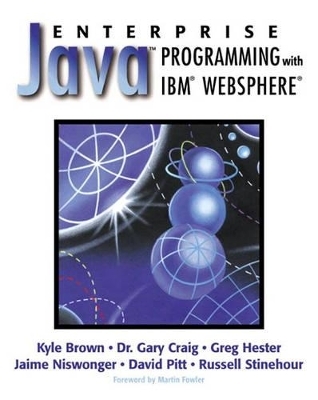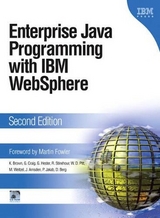
Enterprise Java™ Programming with IBM® WebSphere®
Addison Wesley
978-0-201-61617-0 (ISBN)
- Titel erscheint in neuer Auflage
- Artikel merken
PLEASE PROVIDE
WebSphere is at the heart of IBM's web strategy: a global Internet software platform that can support any e-business, from startup to megasite. IBM is investing $1 billion to build a WebSphere community that will be 5,000,000 developers strong. Now, there's a comprehensive WebSphere programmer's reference: a hands-on, solutions-focused exploration of every key element of WebSphere server-side programming, including Java servlets, JavaServer Pages, Enterprise JavaBeans, and IBM's powerful VisualAge for Java development environment. They present detailed guidance for architecting WebSphere/J2EE applications that deliver maximum performance, scalability, and robustness. Finally, using a start-to-finish case study, they build an entire system, showing how every piece fits together, how each API interrelates, and exactly how IBM's VisualAge for Java Enterprise Edition and WebSphere implement the J2EE standards.
Kyle Brown is currently an Executive Java Consultant with IBM WebSphere Services. Dr. Gary Craig is the founder and President of Superlative Software Solutions, Inc. Greg Hester is the Chief Technology Officer of Cross Logic Corporation Jaime Niswonger is a Principal Consultant at Cross Logic Corporation. David Pitt is a Principal Consultant at Cross Logic Corporation. Russell Stinehour is the CEO of Cross Logic Corporation. 0201616173AB09192001
Figures, Tables, and Listings.
Foreword.
Preface.
1. Internet Business Environment.
Web Revenue Projections.
Marketplace Competition.
IT Management Issues.
What Is Needed.
Summary and Preview.
2. Web Based Client/Server Solutions.
Web-Based Client/Server Design Templates.
Remote Presentation.
Distributed Logic.
Remote Data Management.
Distributed Data Management.
J2EE and Server-Side Solutions.
Summary and Preview.
3. MVC and Layered Architectures.
Layering.
Layered Architecture.
Common Layering Schemes.
Layered Architecture Defined.
Other Considerations.
Summary and Preview.
4. Introduction to Servlets.
HTTP Technology Primer.
Background.
Uniform Resource Identifiers.
Requests, Responses, and Headers.
Pulling It All Together.
Servlet Concepts.
Support for Servlets.
Servlet Engines.
Servlet Life Cycle.
An Example Servlet.
Key Classes and Interfaces.
The javax.servlet Package.
The javax.servlet.http Package.
Rationale for Servlets.
Summary and Preview.
5. Developing Servlets Using VisualAge for Java.
IBM WebSphere Test Environment (WTE).
Installing the WTE.
Using the WTE Control Center.
Starting the Servlet Engine.
Testing with the Servlet Engine.
Stopping the Servlet Engine.
Building an Example Servlet in VisualAge.
Configuring the Servlet Engine.
Summary and Preview.
6. Using the IBM WebSphere Application Server - Advanced Edition.
WASAE Architecture.
Some Definitions of WebSphere Components.
Testing the Installation.
Before You Start the Admin Server.
Starting the Admin Server.
Opening the Administrator's Console.
Starting the Default Server.
Starting the Web Server.
Test Using the "Snoop" Servlet.
Creating the "EmployeeSys" Application Server.
Using XML Config.
Configuration Issues.
Application Server versus Web Application.
"Invoker" Servlet.
Summary and Preview.
7. Using IBM WebSphere Studio.
Rationale for WebSphere Studio.
Installing and Starting Studio.
Using Page Designer.
Managing a Web Site.
Importing from VisualAge.
Importing Existing Sites.
Version Control.
Working in a Team.
Summary and Preview.
8. Session State Management.
Some Client-Side Session Approaches.
Cookies.
Hidden Fields.
URL Parameters.
Servlets and Session State.
HttpSession Binding.
How the Session Is Found.
Choosing a Session Identifier.
URL Rewriting.
Third-Tier Session Storage.
WebSphere Persistent Session Storage.
Other Session Storage Options.
Configuring WebSphere 3.5 Session Support.
The Enable Section.
The Cookies Section.
The Persistence Section.
The Intervals Section.
The Tuning Section.
Summary and Preview.
9. Servlet Design Considerations.
Number of Servlets.
State Pattern.
Exception Handling.
Servlet Chaining and Filtering.
Using XML.
Summary and Preview.
10. JavaServer Pages Concepts.
Page Templates and Server-Side Scripting.
Page Compilation: Runtime View.
JSP Syntax.
Scripting Elements.
Directives.
Roles for JSP.
Summary and Preview.
11. JSP Actions, MVC, and Tools.
Programming Models.
JSP Direct Model.
JSP Indirect Model.
JSP Standard Actions.
The useBean Action.
The getProperty and the setProperty Standard Actions.
The Rest of the Standard Action Tags.
JSP Development Tools: WebSphere Page Designer.
JavaBeans, Introspection, and Contracts.
WebSphere Studio and Page Designer.
Testing JSPs.
Configuration of JSPs in the WebSphere Test Environment.
JSP Execution Monitor.
Deploying JSPs.
Support for taglib and XML.
XML Compliance.
Summary and Preview.
12. Servlet and JSP Case Study.
Executing Test Scripts.
Loading the Case Study into the WebSphere Test Environment.
User's Guide.
Initial Screen.
Create, Display, and Modify Time Sheet for an Employee.
Display Pending and Approved Time Sheets.
Case Study Analysis and Design Artifacts.
Problem Statement.
System Tasks.
Use Case List.
Use Case Definitions.
Defined Use Cases.
Time-Sheet Domain Model.
Class Listing.
Collaboration Diagram.
Mediator.
Domain.
Enumeration.
Filtering.
Container.
Time Sheets.
Time-Sheet State.
Mapping.
Package Structure.
Summary and Preview.
13. Enterprise Java Bean Architecture.
Object Distribution.
CORBA Overview.
RMI Overview.
Remaining Problems.
Object Persistence.
Objects and Transactions.
Security in Enterprise Applications.
EJB Definition.
Containers.
Session EJBs.
Entity EJBs.
Need for EJBs.
Summary and Preview.
14. Building Basic EJBs in VisualAge for Java.
The Simplest EJB.
Bean Implementation and Life Cycle.
EJB Home Interfaces.
Building EJBs in VisualAge.
Summary and Preview.
15. Testing and Debugging EJBs in VisualAge for Java.
Overview of the Testing Process.
Debugging EJBs in VisualAge for Java.
Summary and Preview.
16. Writing Simple EJB Clients.
EJB Client Steps.
Obtaining a Home Interface.
Obtaining Home References.
Using the EJB.
EJBObject and Remote Proxies.
VisualAge for Java Access Beans.
Testing EJB Code in the Scrapbook.
Using Servlets as EJB Clients.
Some Design Points about Servlet Clients.
Java Application Clients.
Testing Applications Clients in VisualAge.
Running Application Clients Outside of VisualAge.
Summary and Preview.
17. Simple Container Managed Persistence Entity Beans.
Some Entity Bean Basics.
CMP in WebSphere and VisualAge for Java.
The Parts of an Entity Bean.
Remote Interfaces.
Home Interfaces.
Key Classes.
Finder Helpers.
Bean Implementation Classes.
Summary and Preview.
18. EJB Transactions.
Transaction Defined.
Transactions and Two-Phase Commit.
EJBs and Transactions.
Starting a Transaction.
Participating in a Transaction.
Setting Transaction Attributes.
Transactions and Concurrency.
EJB Caching.
Introduction to Isolation Levels.
WebSphere-Specific Transaction Settings.
Summary and Preview.
19. Building Entity Beans in VisualAge and WebSphere.
Creating an Entity Bean in VisualAge.
Schemas, EJBs, and Table Maps.
Exporting a Schema to a Database.
Some Simple Tests.
Summary and Preview.
20. Advanced CMP Mapping.
Simple Mapping Rules.
Object-Relational Basics.
Concepts in EJB Relationship Mapping.
Associations in UML.
Associations in VisualAge for Java 3.5.
Implementing a Simple Association.
Single-Valued Association Implementation Details.
Implementing Many-Valued Relationships.
Wrapping Up Relationships.
EJB Inheritance in VisualAge.
Remote Interface Inheritance for Sessions and Entities.
Building Inherited Beans in VisualAge.
Inheritance of Home Interfaces.
Database Inheritance Strategies.
CMP Entity Support for Inheritance.
Summary and Preview.
21. Bean Managed Persistence.
Applying BMP.
A Simple BMP Bean.
WebSphere JDBC Connection Pooling.
Examining BMP Persistence.
Writing ejbCreate() Method in BMP Beans.
Writing BMP Finder Methods.
Writing BMP ejbLoad() Methods.
Writing ejbStore() Methods.
BMP versus CMP.
Summary and Preview.
22. Building Layered Architectures for EJB Systems.
Problems with an All-EJB Solution.
The Session Facade and Data Bean Solution.
Examples of the Session Facade/Data Bean Solution.
A Simple Example from the Case Study.
A More Complex Example.
An Updating Example.
Summary and Preview.
23. Deploying EJBs into WebSphere.
Exporting EJBs from VisualAge for Java.
EJB JAR File.
Creating an EJB JAR from VisualAge for Java.
VisualAge Deployed JAR File.
Client JAR File.
Best Practices for EJB Deployment.
Deploying EJBs to WebSphere.
Deploying .jar Files.
Deploying Files from Studio.
Defining EJBs.
Final Changes.
Summary and Preview.
24. A Final Look.
J2EE Application Servers.
Layering: MVC revisited.
Tools.
Parting Comments.
Appendix A: Mapping Domain Objects to Datastores.
Appendix B: Application Service Layers.
Application Services.
The AppService Class.
Startup Sequence.
Exception Handling.
Application Property and Resource Access.
Bibliography.
Index. 0201616173T05042001
| Erscheint lt. Verlag | 21.5.2001 |
|---|---|
| Verlagsort | Boston |
| Sprache | englisch |
| Maße | 187 x 234 mm |
| Gewicht | 845 g |
| Themenwelt | Informatik ► Programmiersprachen / -werkzeuge ► Java |
| Mathematik / Informatik ► Informatik ► Web / Internet | |
| ISBN-10 | 0-201-61617-3 / 0201616173 |
| ISBN-13 | 978-0-201-61617-0 / 9780201616170 |
| Zustand | Neuware |
| Informationen gemäß Produktsicherheitsverordnung (GPSR) | |
| Haben Sie eine Frage zum Produkt? |
aus dem Bereich


